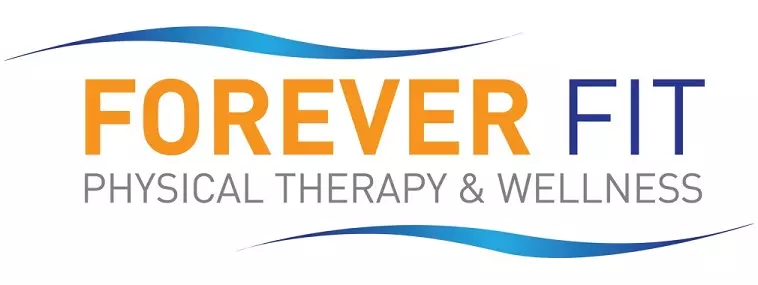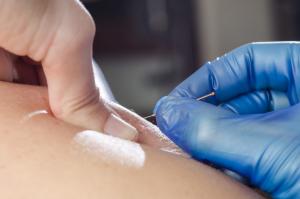What is dry needling?
Trigger point dry needling treats myofascial pain. What then is myofascial pain, you ask? “Myofascial” has two parts. “Myo” refers to muscles, and “fascia” refers to the tissues that connect your muscles.
Sometimes, everyone’s muscles get knotted up. When overused or strained, muscles develop knots that are irritable and painful. When you feel a muscle knot, you will often find it is quite painful to the touch. Maybe the knot goes away, but maybe it lingers. And try as you might, you can’t massage the knot out, even if you can reach it.
These areas are called trigger points.
The aim of dry needling is to untie these muscle knots at their very core at your trigger points. This reduces the pain in the local area, but it also impacts referred areas too. When a dysfunctional muscle or trigger point receives dry needling treatment, it can decrease the tightness, increase the blood flow, and reduce both the local and referred pain. There are even “latent” knots that do not directly cause pain when you touch them but underlie chronic pain issues.
Why is dry needling important?
Dry needling seems to change how the brain and muscles communicate with each other, so your system can return to normal movement patterns.
More people swear by dry needling’s ability to provide relief for even the most intense muscle pain and chronic mobility issues. Athletes, those with injuries, and people coping with chronic pain, discover this drug-free way to treat musculoskeletal pain.
Dry needling trigger point therapy has been around for decades. The focus is on muscle and connective tissue to restore mobility by triggering pain relief. Tiny, thin, solid needles go through the skin into a trigger point to untie the knot. The needle stimulates the tissue. There is no medication injected. That is why the needles are called “dry.”
To locate your trigger points, your physical therapist palpates (examines by touch) the area with their hands. Their specialized training in trigger points means they have studied a map of the human body with common places that trigger points emerge. This knowledge is helpful, but we know that every patient is different. That is the physical therapist’s skill set. They touch the area to locate the trigger point precisely, so they know exactly where to insert the needle.
Can Dry Needling Help With Chronic Pain?
Yes! Dry needling treats the muscle tissues, with the goal to reduce pain, untie those muscle knots and restore function. Seldom used as a standalone procedure, dry needling is part of a plan that incorporates other physical therapy interventions that are added based on each individual patient’s presentation.
What kind of pain can dry needling treat?
Forever Fit Physical Therapy uses dry needling as part of an overall physical therapy plan when necessary.
Dry needling increases range of motion limited because of muscle tightness, pain, or scar tissue. Forever Fit Physical Therapy & Wellness patients find dry needling also treats:
- Disk problems
- Joint problems
- Tendinitis
- Jaw and mouth problems (TMJ or TMD)
- Shoulder pain
- Neck pain
- Migraine and tension-type headaches
- Whiplash
- Spinal issues
- Repetitive motion disorders (like carpal tunnel syndrome)
- Pelvic pain
- Heel pain
- Hip pain
- Back pain
- Phantom pain
- Night cramps
The exact mechanism of dry needling is yet unknown. But what we do know is that inserting that tiny needle into a trigger point causes a favorable biochemical change, which reduces chronic pain.
Although research shows that dry needling is a safe, effective, drug-free approach to treat and manage pain, some insurance companies may not reimburse you for the procedure.
How does it feel to get dry needled?
Short answer, it depends. Yes, everyone’s experience is different but there are a few common descriptions among all the people that have experienced dry needling at Forever Fit. Most of them give descriptors like grabbing, pressing, twitching, weird, and dome others. Many of them will feel the usual pain for which they are coming to get treatment. That is actually a good sign though, it means we are on the right spot. When on the right spot we also see what is called a local twitch response (LTR). The muscle actually twitches and this is when we get some of the best results.
The sensation of getting needled is not a pleasant one for most, but it is nothing unmanageable. The needle used is so thin that it is barely felt on the way in. People usually have to ask if the needle is there or not. You may feel your therapist moving the needle a bit and some of the sensations described above. It lasts about a minute or so per muscle before moving on to the next. The first hour is when the most soreness will be felt but it goes along with a decrease in stiffness. After the first hour things start to calm down and by the next day it just feels like the soreness from exercising. Once that soreness dissipates, people report feeling much better and come back pleased with the results.
Even after having good results with that first dry needling session, there might be some residual symptoms for which patients may need one or two more sessions. Most people see significant improvement after that. So, if you have been told that dry needling could be good for you but you had some hesitation, now you have an idea of what it is like to get it done.
Reach out to us at Forever Fit Physical Therapy & Wellness for a consultation today to determine if dry needling or another form of treatment is right for you!
CURRENTLY, FOREVER FIT PHYSICAL THERAPY & WELLNESS OFFERS DRY NEEDLING SERVICES IN OUR BOWIE AND COLESVILLE ROAD LOCATIONS!!!!

